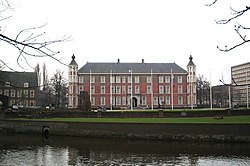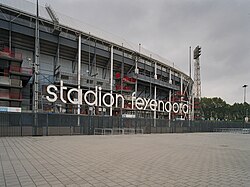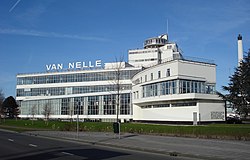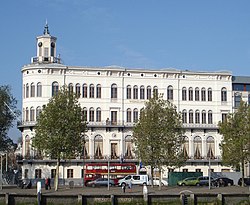| Rijksmonument | Type | Location | Description | Photo |
|---|
| American Hotel | Hotel | Amsterdam | A hotel built in 1900. |  |
| Centraal Station | Railway station | Amsterdam | The main railway station in Amsterdam. Built in 1889. |  |
| Astoria | Offices | Amsterdam | An Art Nouveau office block built in 1905. |  |
| Castle Brederode | Castle | Santpoort-Zuid | A castle built by the Lords of Brederode in the second half of the 13th century. |  |
| De Duif | Church | Amsterdam | A Roman Catholic church built in 1858. |  |
| De Krijtberg | Church | Amsterdam | A Roman Catholic church built in 1883. |  |
De Schoolmeester
No. 40013 | Windmill | Westzaan | A smock mill built in 1692, restored to working order. It is the only surviving wind powered paper mill in the world. |  |
| Hollandsche Manege | Riding school | Amsterdam | Offices, accommodation and stables built in 1883. |  |
| Lange Jaap | Lighthouse | Huisduinen | A cast iron lighthouse built in 1878 | 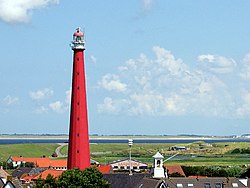 |
| Muiderslot | Castle | Muiden | A castle build by Floris V, to guard the mouth of the river Vecht. |  |
| Museum De Cruquius | Pumping station | Cruquius | A steam powered pumping station built c. 1850. Houses the largest stationary steam engine (a beam engine) in the world. Also a World Heritage Site. |  |
| Nieuwe Kerk | Church | Amsterdam | A church dating from the 15th century. Used for Royal Inaugurations and Royal Weddings. Also used as an exhibition venue and for organ recitals. |  |
| Noorderkerk | Church | Amsterdam | A Protestant church built in the 1620s. |  |
| Olympisch Stadion | Stadium | Amsterdam | A stadium built for the 1928 Summer Olympics and later used by AFC Ajax until 1996. | 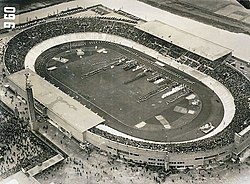 |
| Onderlinge van 1719 u.a. | Offices | Haarlem | Residential building from 1870. Good example of Eclectic style by architect A. van der Steur. Seat of an insurance firm established in 1719 |  |
| Oost-Indisch Huis | Offices | Amsterdam | An early 17th-century office block. Former headquarters of the Dutch East India Company. |  |
| Oosterkerk | Church | Amsterdam | A former Protestant church built between 1669 and 1671. |  |
| Oude Kerk | Church | Amsterdam | A former Roman Catholic and current Protestant church. It was consecrated in 1306. The oldest parish church in Amsterdam. |  |
| Portugees-Israëlietische Synagoge | Synagogue | Amsterdam | A synagogue built in 1671. |  |
Koninklijk Paleis
Paleis op de Dam | Palace | Amsterdam | Originally built as the City Hall in 1655. first used as a Royal Palace by Konig Louis I and still used as such by the current monarch. | 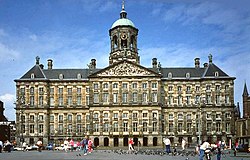 |
| Smedestraat 33 | Doorway | Haarlem | The doorway's brickwork, including a round false window, is from the second half of the 17th century. |  |
| Stadsschouwburg | Theatre | Amsterdam | A theatre built between 1892 and 1894. Former home of De Nederlandse Opera. |  |
| Statue of Jan Pieterszoon Coen | Statue | Hoorn | Statue of Jan Pieterszoon Coen, made in 1887, placed in 1893. |  |
| Stoomgemaal Vier Noorder Koggen | Pumping station | Medemblik | Steam powered pumping station near the city of Medemblik. Build in 1869 and expanded in 1907, to obsolete 25 windmills. |  |
| Grote or Sint-Laurenskerk | Church | Alkmaar | A gothic church dedicated to St. Lawrence, now a Protestant church. Contains the tomb of Floris V, Count of Holland. |  |
| Vondelpark | Urban park | Amsterdam | A public park established in 1865 and extended in 1877. | 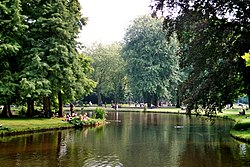 |
| Westerkerk | Church | Amsterdam | A Protestant church built between 1620 and 1633. Burial place of Rembrandt. | 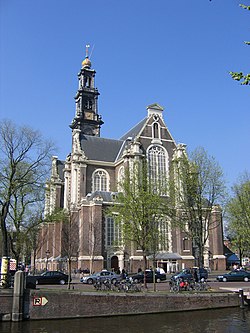 |
| Zuiderkerk | Church | Amsterdam | A former Protestant church built between 1603 and 1611. In use as a church until 1970, now an information centre. |  |




